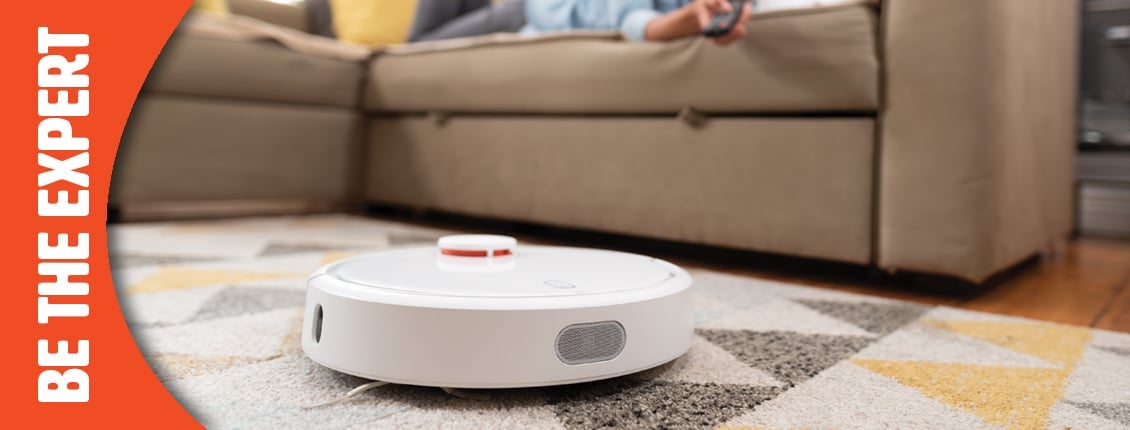
Everything You Need to Know About These Everyday Helpers
By now, you’ve probably heard of “roombas” or “robotic vacuums”, and you might even own one yourself. They’re a nice supplement for standard upright vacuums, and some people even use them to exclusively clean their floors.
But how do they function? Are they worth the investment?
Let’s break down the basics of robot vacuums and learn how they function, the pros of purchasing one, and the limitation of the technology.
What is a robot vacuum?
Robot vacuums (often generically referred to as “Roombas”, even though that’s a specific brand) are vacuum cleaners with intelligent programming, allowing them to function autonomously and with little human input.
Most feature both remote control functions and “self-driving” modes, meaning they’re easy to simply turn on and let off the leash to complete their cleaning routine.
More expensive and state-of-the-art models boast functions like mopping and UV sterilization, but basic and more affordable options simply feature the brushes and bristles of a regular vacuum.
How do robot vacuums work?
Robot vacuums boast self-navigation systems—which is what makes them robotic—which means they need only minimal human guidance.
The biggest price point difference between different models is often how precise these navigation systems are. Lower price point models have simpler navigation systems, while high-end robot vacuums feature cutting edge tech that can map out floor plans of entire homes. Most robot vacuums feature rechargeable batteries (often Lithium-Ion) and are packaged with charging stations.
How’s the vacuuming tech?
Of course, all of the fancy navigation doesn’t mean anything if our robot can’t vacuum!
Robot vacuums have much of the same tech as upright vacuums, including spinning brushes, agitators, and, of course, vacuums. In lieu of bags, they have dirt bins attached to their hindquarters, and these generally need to be emptied after every room (depending on how dirty the floors are). These bins feature filters that need to be changed out occasionally, just like bags in upright vacuums.
The Pros of Purchasing Robot Vacuums
Robot vacuums boast several features that make them handy household helpers. To start, they’re easy to control and autonomous. Through apps and remote controls, users can schedule and command robot vacuums to clean areas, rooms, or even entire houses/floors.
And once those cleaning parameters are set, the vacuum will complete its cleaning cycle on its own and return to its docking station—all with little to no human interaction. This can save people untold amounts of time and hassle. They’re ideal for touch-up and spot cleaning when company is coming, allowing their users to focus on other important tasks.
And they can run anywhere from 40 minutes to two hours, depending on the sizer of the job at hand.
The Limitations of Technology
Of course, these robotic helpers don’t come without their limitations. While they require little human help while running, robot vacuums don’t have the environmental awareness of humans.
Any stray socks, cables, or pet messes that the user is unaware of can be caught in the robot, which can damage both it and the flooring. And when it comes to vacuuming power, upright vacuums mop the floor with their robotic counterparts. According to an experiment conducted by Consumer Reports, “the… upright [vacuum] picked up more than half of the debris; the…robovac picked up less than 20 percent, proving that for deep cleaning, a bot is no match for a traditional vacuum.”
For anyone looking to seriously clean their carpets and floors, an upright vacuum is the ideal choice.
Finally, robot vacuums can run a hefty price tag. Simple models can run as cheap as $50, while those boosting all of the bells and whistles newer models feature can around $1,800.
The World of Tomorrow Today
Robot vacuums are no longer something out of a sci-fi movie, but they do have their limitations.
So, should your customers look at purchasing one?
As always, it depends on their needs. Are they looking to supplement their upright vacuum with a helpful spot cleaner they can run every now and again?
A robot vacuum is probably a good choice.
However, completely replacing their upright vacuum with a robot isn’t going to fetch the same level of cleanliness. Make sure they consider the cost and limitations of the technology before they make their investment. If you’re looking for more deep dives about trending products and categories, make sure to visit petra.com/blog.
